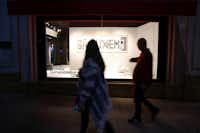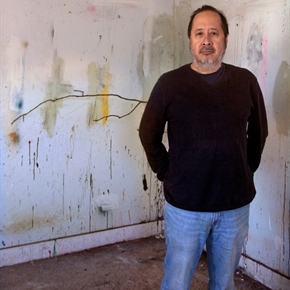Dallas' Stephen Lapthisophon has made an enormous contribution to his adopted city's creative scene as an artist, teacher and mentor. Now the Dallas Art Fair has named him its artist/educator honoree for 2019.
Lapthisophon is also “on the town” this month with his works on display in the store windows at the venerable downtown Neiman Marcus, with a billboard of his piece Fifty Years Later in Fort Worth sponsored by the Modern Art Museum of Fort Worth, and with works appearing prominently at the Dallas Art Fair.
I must come clean and say that I have known Lapthisophon for longer than either of us care to admit (since 1976!). Then, he was a brilliant art student at the University of Texas at Austin, and I was a very junior professor of art history there. We got to know each other because Lapthisophon did very well in one of my classes and shyly asked if I might be a member of his committee in his senior year.
I had to admit to him that I thought “art” and “art history” were as alike as “creative writing” and “old English literature,” but I said I would give it a shot. Little did I know that his other two committee members were the late Gary Winograd, one of the 20th century’s greatest photographers, and Richard Jordan, the most exacting professor of painting then at Austin (and, still to this day, one of the least known and most private painters in Texas). We were an unlikely trio that, perhaps because it was unlikely, bonded to help this promising student, who was only a few years younger than I was.
Embrace your self worth, not your net worth.

A thriving career
Lapthisophon himself is a bundle of contradictions — an only child raised in Houston whose parents were both public school teachers. His Thai-born father taught science, and his small-town Nebraska-born mother taught history. Wrap your mind around the implications of all that.
Our time together at UT Austin was a learning experience for both of us, but Lapthisophon was the avant-garde one. Not only did he deposit small works of art all over the art building in his senior year (I think there may still be one or two that no one has yet found), but he decided to jump ship after graduating to attend graduate school in Chicago for his master's in fine arts at the Art Institute of Chicago.
I followed him there three years later to become the curator of European paintings at the very same institution. By then, our student-teacher relationship had morphed into a friendship that has endured to this day. I wrote a letter of recommendation for him to enter the Ph.D. program in comparative literature and theory at Northwestern University, where he did everything but a dissertation and began his writing and publishing career. The dominant intellectual influence on this thought then was the brilliant Marxist art historian O.K. Werckmeister.
I was very happy when Lapthisophon, years later, decided to join me in Dallas, where, despite all the setbacks that often accompany a career as an artist in contemporary American society, he has thrived.
He is a rigorous, challenging and deeply committed teacher — both at the University of Texas at Arlington, where he has been a senior lecturer for more than a decade, and at the University of Texas at Dallas, where he has taught art and art theory occasionally.

Legally blind
Lapthisophon has chosen to live in a beautiful yellow-brick house in Oak Cliff with a small two-story backyard studio (a former garage with what was probably a rental room on the second floor). His works of art on paper, canvas and notebooks are everywhere — some pinned to the wall, others in stacks, some stuck together, and some already stretched on canvas in one or another stage of completion.
What is remarkable is that Lapthisophon remains a committed artist while being legally blind. He cannot drive (and, thus, knows Dallas public transportation better than the head of the agency that runs it). When he takes walks, he does so already knowing the route, often befriending a dog or two in other people’s yards.
He lights up when he hears a familiar voice before he sees you, and he studies his own and his students’ art with supreme effort — looking sideways, turning his head, getting very, very close, and, with all the diverse stimulation, putting these visual sensations together in his mind. For him, seeing is a complex exercise of optical and mental synergy that is anything but “natural.” For that reason, what he sees matters because his disability allows him to understand that “seeing” involves the brain as well as the eye.
When he makes a drawn or painted gesture, he does so because his body knows the limits and character of that gesture before his eye does. And his sense of the materiality of art comes as much from the kitchen as from the studio. Indeed, the act of turning “ingredients” into a meal is, in some profound sense, like turning material into art. His work has used matter commonly associated with the kitchen — coffee, spices, bacon grease and other food materials on paper, canvas and even, in some important cases, the wall itself. He also uses ink, paint and other traditional artistic mediums.
When Lapthisophon became one of the few Dallas artists chosen to have a room-size installation in the Dallas Museum of Art as part of the Concentrations Series, he worked closely with curator Gabriel Ritter to create one of his most ambitious and enveloping pieces on the walls and floors of two adjacent rooms in the Hoffman Galleries.
Challenging work
Lapthisophon’s “medium” is both mental and physical — old furniture, books, records, domestic objects, pigment, paper, ink, foodstuffs, and, almost always, words, letters and/or numbers. Hence, his installations encompass not only painting, sculpture and architecture, but also ideas.
Perhaps because it is so difficult for him to read (he uses an amazing machine that transforms print into sound), he reads carefully and repeatedly — as if caressing certain favored texts with his eye and mind and ear. As such, their elements become almost intellectual fetishes, which he picks apart and recombines in his work for his unwary reader/viewer.
It is never enough simply to look at a work or an installation by Lapthisophon, and it is his combination of formal and intellectual control that gives his art a unique character. Even his fluent painted and drawn gestures have their origins in calligraphy or gestured writing, which is, in all Asian languages, deliberately difficult to read.

In the online and written material produced by the Dallas Art Fair, Lapthisophon is reduced to a two-word phrase — “conceptual artist.” This characterization is both true and completely false at the same time. His art produces responses that are often more intellectual than optical, but it does so with a firm commitment to the materials and gestures of the visual artist.
In our current historical moment of big data and short attention spans, his art forces us to slow down and to “read” it just as he reads and looks — with effort. The more time and effort we take, the more we derive from his visual ciphers. That they are worth the wait goes without saying. Let’s hope that we will make the time for them that they deserve.
Lapthisophon’s is not an art to be “liked,” but to be savored.
Rick Brettell is a contributing writer and the former art critic of The Dallas Morning News. He is the founding director of the Edith O'Donnell Institute of Art History at the University of Texas at Dallas and a former director of the Dallas Museum of Art.



